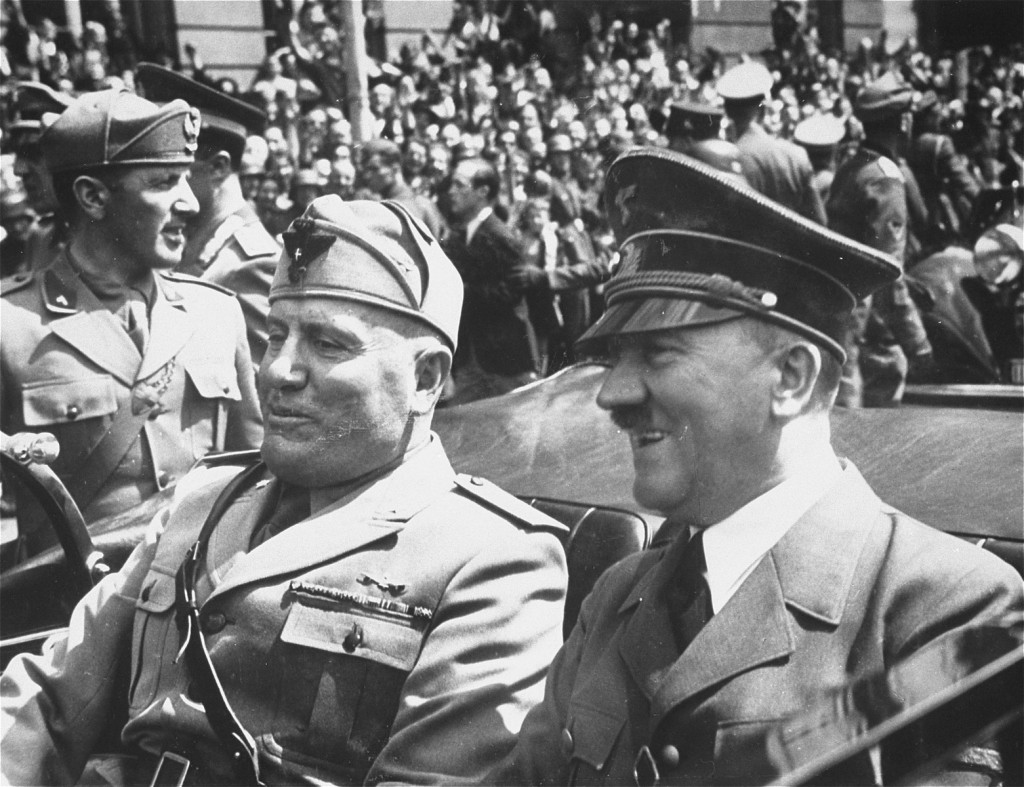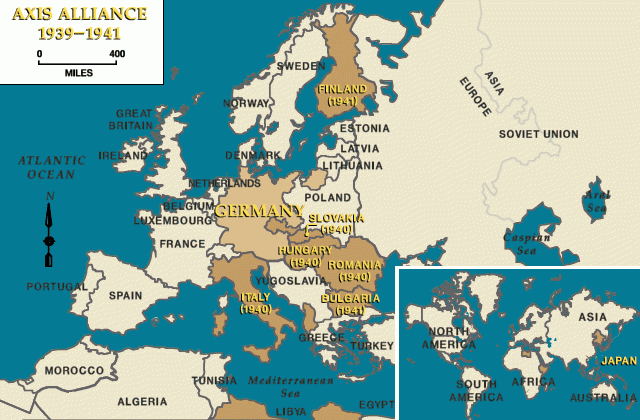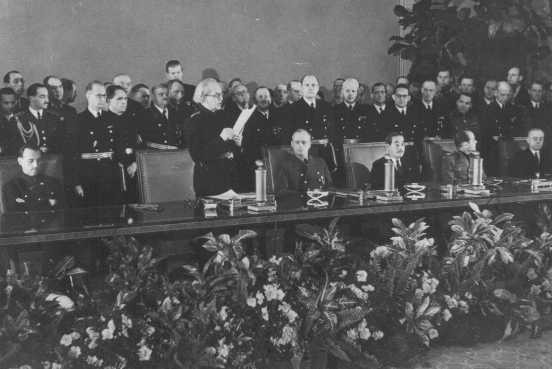
Axis Powers in World War II
The three principal partners in the Axis alliance were Germany, Italy, and Japan. These three countries recognized German and Italian dominance in continental Europe, as well as Japanese domination over East Asia. Five other European states joined the Axis alliance during World War II. All of Germany’s European Axis allies participated to some degree in the persecution and murder of Jews during the Holocaust.
Key Facts
-
1
The Axis powers (Germany, Italy, Japan) were opposed by the Allied Powers (led by Great Britain, the United States, and the Soviet Union).
-
2
Five other nations joined the Axis during World War II: Hungary, Romania, Bulgaria, Slovakia, and Croatia.
-
3
The decline and fall of the Axis alliance began in 1943.
Major Alliances during World War II (1939-1945)
There were two major alliances during World War II: the Axis powers and the Allied powers.
The three principal partners in what was eventually referred to as the Axis alliance were Germany, Italy, and Japan. These countries were led by German dictator Adolf Hitler, Italian dictator Benito Mussolini, and Japanese Emperor Hirohito. In September 1940, the three countries formalized their alliance through the Tripartite Pact. Five other countries subsequently joined the Tripartite Pact and became Axis powers. They were Bulgaria, Croatia, Hungary, Romania, and Slovakia. Each of Germany’s six European Axis allies participated in the Holocaust by murdering Jews or by transferring them to German custody to be murdered.
The Allied Powers were led by Great Britain, the United States, and the Soviet Union. These countries were led by British Prime Minister Winston Churchill, US President Franklin D. Roosevelt, and Soviet Premier Joseph Stalin. They formally allied by signing the Declaration by United Nations on January 1, 1942. Fifteen other independent states also signed the Declaration on that date. In addition, the Declaration was signed by the governments-in-exile of another eight states that were occupied by the Axis powers at the time. Twenty-one other states declared war on Germany and signed the Declaration by March 1945.
Unlike the Allies, the Axis powers never developed institutions to coordinate foreign policy or direct combined military operations. Nevertheless, they pledged mutual military and political support.
Formation of the Axis Alliance
In the late 1930s, each of the three powers that would form the Axis alliance launched campaigns of territorial expansion that alienated most of the world’s other major powers.
Italy invaded Ethiopia (then also known as Abyssinia) on October 3, 1935.
Japan had already seized Manchuria (a part of China) on September 18, 1931. Then, on July 7, 1937, Japan invaded the rest of China, initiating the war in the Pacific.
Germany began its prewar expansion in 1938 by annexing Austria and the Sudetenland (a part of Czechoslovakia). In March 1939, the Germans divided the rest of Czechoslovakia between the German-controlled Protectorate of Bohemia and Moravia and the newly created satellite state of Slovakia.
Their aggression against other states left Germany, Italy, and Japan with few friends among the world’s countries. To end their isolation, the three nations began to draw closer and entered into treaties and pacts.
Rome-Berlin Axis
Italy and Germany began to pursue closer relations in 1936 after the League of Nations imposed sanctions on Italy for invading Abyssinia and after Italy’s alliance with Britain and France ended. On October 25, 1936, Germany and Italy entered into a treaty of friendship in which they pledged to pursue a common foreign policy. Based on a speech given by Mussolini a week later, the alliance became known as the Rome-Berlin Axis.
Anti-Comintern Pact
On November 25, 1936, a month after Germany and Italy entered into a treaty of friendship, Nazi Germany and Imperial Japan signed the Anti-Comintern Pact. In this pact, the two countries pledged mutual assistance in combating the threat posed by the Communist International. Although the pact does not mention the Soviet Union, it was directed at that country, which was in hostilities with Japan at the time. Italy joined the Anti-Comintern Pact on November 6, 1937.
Pact of Steel
On May 22, 1939, Germany and Italy expanded their political alliance into a military one by signing the Pact of Friendship and Alliance. Dubbed the Pact of Steel by Mussolini, the agreement provided for military cooperation and mutual defensive support between Germany and Italy.
World War II began on September 1, 1939, when Germany attacked Poland. Two days later, Britain and France declared war on Germany. Despite the Pact of Steel, Italy at first remained neutral. On June 10, 1940, shortly before Germany defeated France, Italy joined the war as Germany’s ally. In addition to invading France, Italian forces attacked British interests in North and East Africa.
Tripartite Pact
On September 27, 1940, Germany, Italy, and Japan signed the Tripartite Pact. This pact formalized the alliance between the three countries, which subsequently were referred to as the Axis powers.
In the Pact, Japan recognized “the leadership of Germany and Italy in the establishment of a new order in Europe.” In return, Germany and Italy recognized Japan’s right to establish a new order “in greater East Asia.”
The signatories agreed to come to one another's aid in the event of an attack by a nation with which none of the signatories was then at war. This provision was intended as a warning to the United States to stay out of Germany and Italy’s wars in Europe and North Africa. It was also a warning to the United States to refrain from interfering with Japan’s conquests in East Asia.
Germany Pressures other European States to Join the Axis Powers

In July 1940, just weeks after the defeat of France, Hitler decided that Nazi Germany would attack the Soviet Union the following spring. To do so, Germany needed to secure raw materials; establish transit rights for German troops; and ensure the cooperation or participation of other European states. Thus, Germany began to cajole and pressure those European states that were sympathetic to the Nazi regime to join the Axis. Nazi Germany offered economic aid to Slovakia. It also offered military protection and Soviet territory to Romania. And it warned Hungary that Germany might retract its recent support for Hungarian annexations of Czechoslovak and Romanian territory.
When Italy failed to conquer Greece in the late autumn and winter of 1940–1941, Germany became more concerned about securing its southeastern flank in the Balkans. Greece’s success in repulsing Italian forces allowed its ally, Great Britain, to establish a foothold on the European continent. To subdue Greece and move the British off the European mainland, Nazi Germany sought to bring Yugoslavia and Bulgaria into the Axis alliance as well.
Hungary
Hungary was beholden to Germany and Italy for awarding it part of Czechoslovakia in 1938 and approving its annexation of Northern Transylvania from Romania in September 1940. Hungary’s leaders were also eager for preferential economic treatment from Nazi Germany. Hungary joined the Axis alliance on November 20, 1940.
Romania
Having requested and received a German military mission in October 1940, Romania joined the Axis on November 23, 1940. The Romanians hoped that loyal support for a German invasion of the Soviet Union and faithful oil deliveries would: 1) destroy the Soviet threat; 2) return to Romania provinces annexed by the Soviet Union in June 1940; and 3) win German support for the return of Northern Transylvania.
Slovakia
Slovakia was both politically and economically dependent on Germany for its existence as a sovereign state. Thus, Slovakia followed suit and joined the Axis alliance on November 24, 1940.

Bulgaria
Initially, Bulgarian leaders stalled and resisted German pressure to join the Axis alliance. They were reluctant to get involved in a war with the Soviet Union. They also did not want to antagonize Yugoslavia, which was nominally an ally of Greece. However, Bulgaria joined the Axis after the Germans offered them Greek territory in Thrace. The Germans also exempted Bulgaria from participation in the invasion of the Soviet Union. Bulgaria joined the Axis on March 1, 1941.

Yugoslavia
Yugoslavia reluctantly joined the Axis on March 25, 1941. It did so because the Germans agreed to respect Yugoslav neutrality in the war against Greece and did not demand transit rights for Axis troops. Two days later, Serbian military officers who objected to the Tripartite Pact overthrew the Yugoslav government that had signed it. This enraged Hitler. Germany attacked Yugoslavia on April 6 and Italy and Hungary soon joined in the invasion. Yugoslavia was defeated, dismembered, and occupied by the Axis powers by mid-April 1941. Consequently, Yugoslavia never actually became one of the Axis powers.
Croatia
As part of the dismemberment of Yugoslavia, the Axis powers created a satellite state called the Independent State of Croatia. It was run by Croats who belonged to the fascist Ustaša movement. The Independent State of Croatia joined the Axis on June 15, 1941.
Finland
On June 26, 1941, four days after the Axis invasion of the Soviet Union, Finland entered the war against the USSR as a “co-belligerent.” The Finns sought to regain territory lost during the 1939–1940 Winter War with the Soviet Union. Finland never signed the Tripartite Pact or entered into a formal alliance with Nazi Germany. However, it did allow German forces to transit and operate from Finnish territory, and Finnish forces fought alongside the Germans. Since it functioned as an ally of Nazi Germany, Finland is sometimes incorrectly referred to as one of the Axis powers.
Disintegration and Defeat of the Axis
On December 7, 1941, Japan launched a surprise attack on the United States at Pearl Harbor. Within days, Germany and the European Axis powers declared war against the United States. In response, the United States, Great Britain, the Soviet Union, China, and twenty-two other governments formally declared that they would work together to defeat the Axis powers. Twenty-one additional governments joined their alliance before the end of the war.
Consequently, at the start of 1942, Germany and its allies found themselves fighting a world war. By early 1943, accumulating military losses in Europe and Africa began to erode some of the Axis powers’ commitments to one another.
Italy
Italy was the first Axis partner to give up.
In late July 1943, leaders of the Italian Fascist Party deposed and arrested Fascist leader and Italian dictator Benito Mussolini. Italy surrendered to the Allies on September 8, 1943.
German forces occupied the northern half of Italy and freed Mussolini from prison. Mussolini then established the Italian Social Republic, which was based in the northern Italian town of Salò and was completely dependent upon Germany.
Romania
On August 23, 1944, following the overthrow of dictator Marshal Ion Antonescu, Romania switched sides. Romanian troops fought alongside Soviet troops for the remainder of the war.
Bulgaria
After the Soviets rejected its offer of an armistice, Bulgaria surrendered on September 8, 1944. The Bulgarian Communist-led Fatherland Front seized power in a coup from the pro-Axis Bulgarian government. It then declared war on Nazi Germany.
Finland
On September 19, 1944, Finland signed an armistice with the Soviet Union.
Hungary
In March 1944, Germany forced Hungary to accept occupation by German forces. The primary reason for Germany’s occupation was its legitimate fear that Hungary would desert the Axis, as Italy had done six months earlier. Hungary never surrendered. The war ended for Hungary in early April 1945, when the Soviet Union’s Red Army drove the last German and Hungarian forces from Hungarian territory.
Slovakia
A national uprising against the pro-Nazi Slovak government broke out in Slovakia in late August 1944. In response, Germany occupied Slovakia to suppress the revolt. Slovakia remained in the Axis until the Soviets captured the capital, Bratislava, in early April 1945.
Croatia
Fanatical remnants of the Croatian Ustaša remained in Croatia until the end of April 1945, when they were captured or driven across the border into German-occupied Slovenia and Austria by Yugoslav Communist-led partisans.
Germany
Following Hitler’s suicide on April 30, 1945, Nazi Germany surrendered unconditionally to the Allies on May 8–9.
Japan
After the defeat of all its Axis allies, Japan fought alone during the summer of 1945. It formally surrendered on September 2, 1945.
Critical Thinking Questions
Why did other countries in Europe join the Axis alliance? Consider different examples.
How did each nation's choice support its own national goals?
Which countries that joined the Axis alliance supported or resisted Nazi racial ideology? What were the motivations for either choice?

